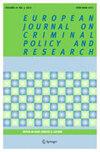Bidirectional Intimate Partner Violence During COVID-19 in Portugal: Prevalence and Psychosocial Correlates
IF 1.8
3区 社会学
Q2 CRIMINOLOGY & PENOLOGY
European Journal on Criminal Policy and Research
Pub Date : 2023-10-19
DOI:10.1007/s10610-023-09565-7
引用次数: 0
Abstract
Abstract Several studies demonstrated that intimate bidirectional violence (BV) is more common than unidirectional IPV. However, little is known about the phenomenon of BV during COVID-19 lockdowns. The present study focuses on BV during the second lockdown in Portugal to characterize the BV rates in an online sample from the community and identify the main psychosocial correlates associated with BV. Three hundred and thirty-six Portuguese adults, with a mean age of 35.02 years (SD = 11.67; 18–68 years), participated in this study. In addition to a sociodemographic questionnaire, IPV (victimization and perpetration), psychological distress, COVID-19-related anxiety, COVID-19 fear, and life satisfaction measures were used. BV (31.3%) emerged as the most reported pattern of violence. The BV group scored higher on psychological distress and depression than the nonviolence group. Being married/living in cohabitation, having a high level of education, working on the front line (during the COVID-19 pandemic), and having psychological distress emerged as important predictors of BV. Results emphasized the role of psychosocial dimensions, particularly marital status/cohabitation and educational levels, as relevant risk factors for BV during a worldwide crisis event. The assessment, prevention, and intervention of IPV should consider the possibility of BV, providing a response congruent with its specificities.葡萄牙2019冠状病毒病期间的双向亲密伴侣暴力:患病率和社会心理相关因素
一些研究表明,亲密双向暴力(BV)比单向IPV更为常见。然而,在COVID-19封锁期间,人们对BV现象知之甚少。本研究侧重于葡萄牙第二次封锁期间的细菌性脑膜炎,以表征来自社区的在线样本中的细菌性脑膜炎发病率,并确定与细菌性脑膜炎相关的主要社会心理相关因素。336名葡萄牙成年人,平均年龄35.02岁(SD = 11.67;18-68岁),参加了本研究。除了社会人口学调查问卷外,还使用了IPV(受害和犯罪)、心理困扰、与COVID-19相关的焦虑、COVID-19恐惧和生活满意度测量。性暴力(31.3%)是报告最多的暴力形式。暴力组在心理困扰和抑郁方面的得分高于非暴力组。已婚/同居、受教育程度高、在前线工作(在COVID-19大流行期间)以及有心理困扰成为BV的重要预测因素。结果强调了心理社会维度,特别是婚姻状况/同居和教育水平,作为世界性危机事件中细菌性感染的相关风险因素的作用。IPV的评估、预防和干预应考虑细菌性阴道炎的可能性,提供符合其特殊性的应对措施。
本文章由计算机程序翻译,如有差异,请以英文原文为准。
求助全文
约1分钟内获得全文
求助全文
来源期刊

European Journal on Criminal Policy and Research
CRIMINOLOGY & PENOLOGY-
CiteScore
4.60
自引率
5.90%
发文量
31
期刊介绍:
The European Journal on Criminal Policy and Research is a peer-reviewed criminology journal, with an international and interdisciplinary focus. It welcomes submissions from Europe and well beyond, from different disciplines and traditions, where crime issues are connected to their socio-, psychological and economic contexts. The focus of its peer-reviewed coverage is on understanding crime trends in different geographical and socio-economic contexts, on presenting innovative crime prevention policies and practices, presenting innovative methodologies, and on following legislative and institutional change. The journal aims to strengthen the link between research and policies in the area of crime and justice, and welcomes submissions with a policy-related component.Discussion includes the trade-off between security and rights and ways to optimize the effectiveness of criminal justice systems with respect to human and civil rights. Recognizing that criminal justice systems are not the only method for dealing with crime, the journal also devotes attention to alternative policies and practices.Its four annual issues include one thematic issue and three that are open to various contributions.
 求助内容:
求助内容: 应助结果提醒方式:
应助结果提醒方式:


